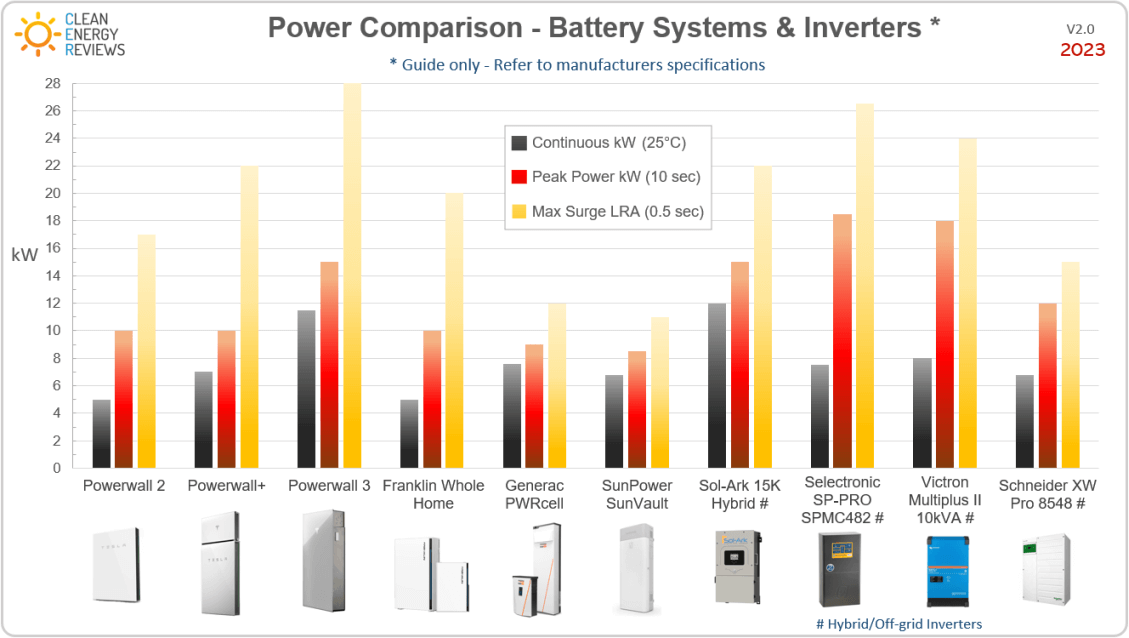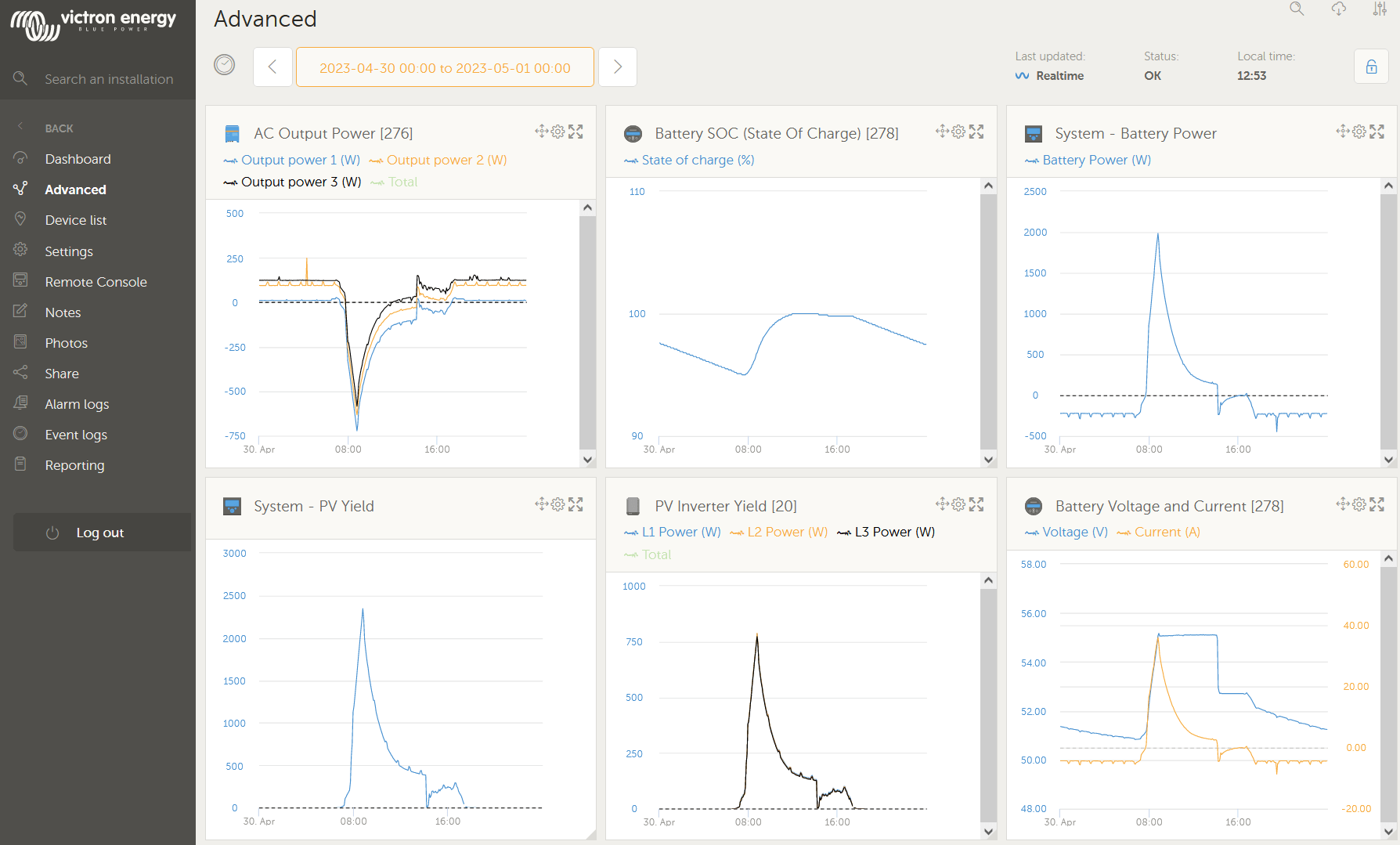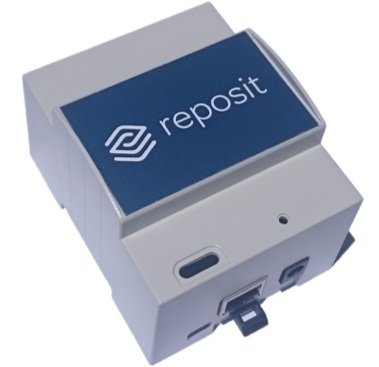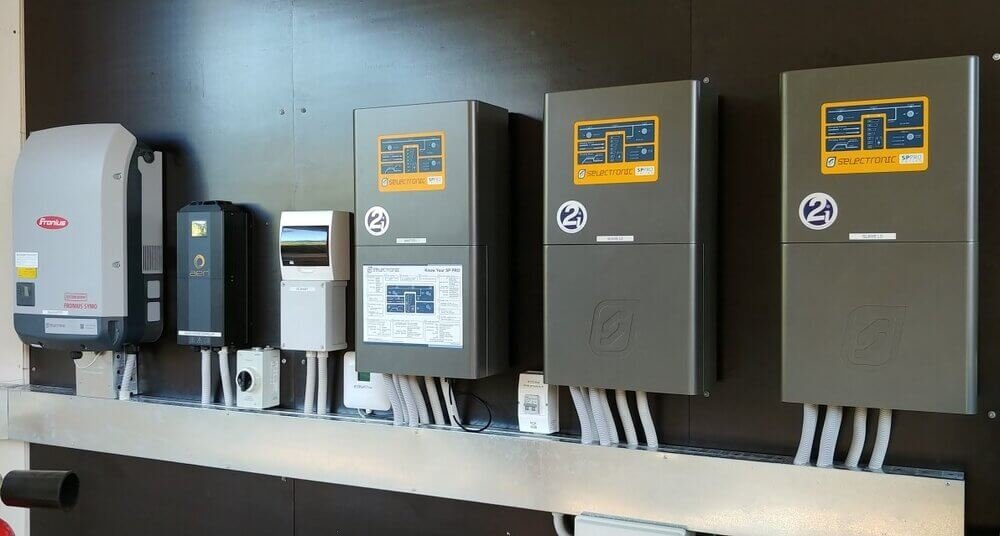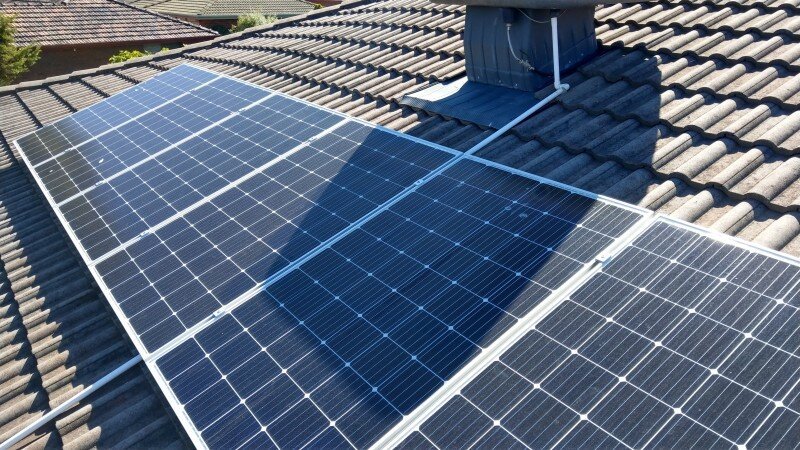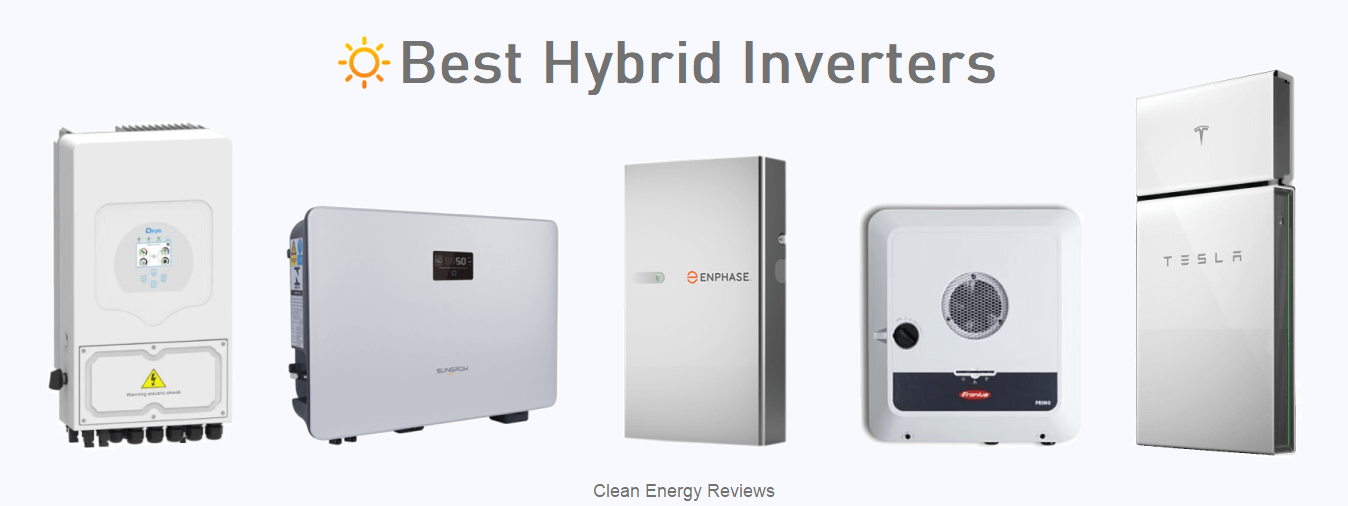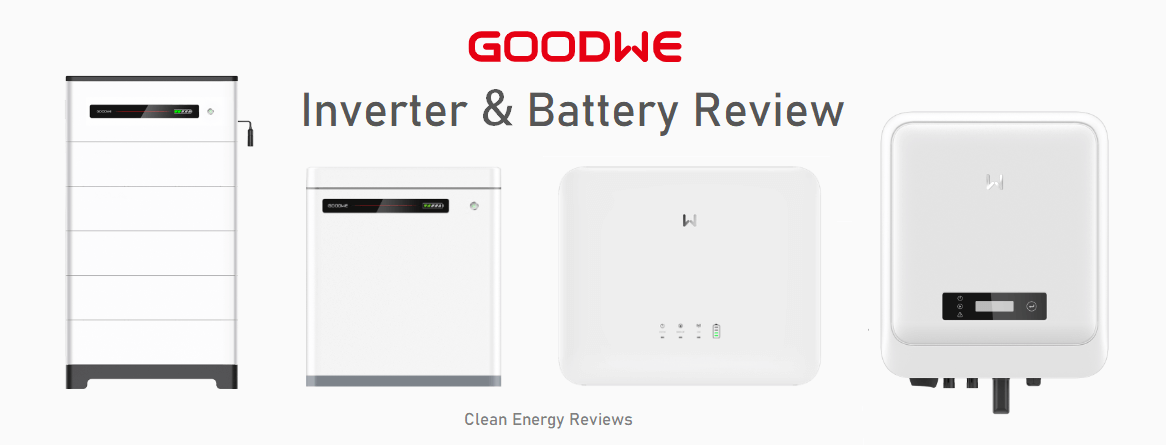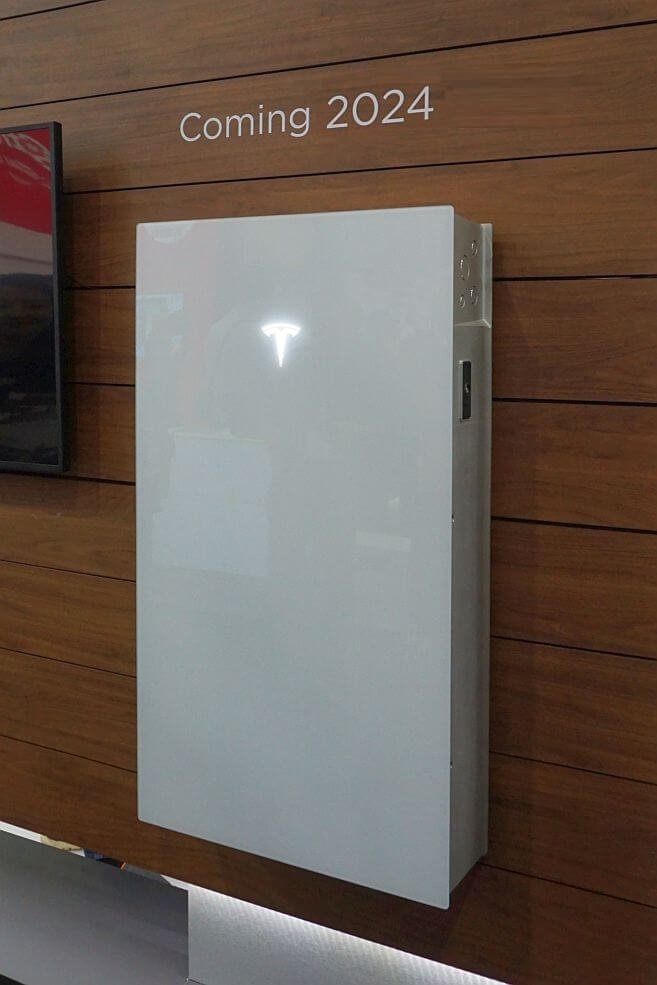Guide to designing off-grid and hybrid solar systems
Diagram - Basic configuration of an AC coupled hybrid grid-connected power system
This is a technical guide for those with a basic understanding of solar and off-grid inverters. For less technical information, see the basic guide to selecting a home grid-tie or off-grid solar battery system. Solar and battery storage systems should always be installed by a licensed electrical professional.
Steps to Designing An off-grid Solar or Battery System
Before purchasing any equipment required for a solar battery (hybrid) or off-grid power system, it is very important to understand the basics of designing and sizing energy storage systems. As explained below, the first part of the process is developing a load profile or using a load calculator to estimate the amount of energy required to be generated and stored daily. If you cannot develop a load table, a professional solar installer or system designer should be consulted.
Step 1 - Estimate the loads
The most important part of designing any off-grid solar or battery system is calculating how much energy is required per day in kWh. For grid-connected sites, detailed load profile data can be obtained using meters to measure the loads directly. For off-grid or stand-alone power systems, always start by using an off-grid load calculator (load table) for summer and winter requirements. The load table will also help calculate surge loads, power factors, and the maximum demand required to size an appropriate off-grid inverter.
Step 2 - Battery sizing
Battery capacity is measured in either Ah or Wh. Lead-acid (deep-cycle) batteries are sized in Ah, while lithium battery capacity is measured in kWh. All loss factors need to be considered to ensure the battery size is adequate to meet the loads, including maximum allowable depth of discharge (DoD) and round-trip efficiency. Also, consider battery type and chemistry, battery voltage range, minimum days of autonomy (continuous days without sunshine), and maximum battery charge rate (C rating), as explained in detail later.
Step 3 - Solar array sizing
A correctly sized solar array is required to charge the battery while also supplying the loads. To ensure the solar array is large enough, consider local conditions, including average solar irradiance throughout the year (peak sun hours), shading issues, panel orientation and tilt angle, cable losses, and temperature derating (loss factors). Our Photonik solar design tool can help estimate solar generation throughout the year, depending on the panel orientation and location.
Step 4 - Inverter selection
After steps 1 to 3 have been established, you can then select a suitable solar inverter or MPPT Solar Charge Controller to match the solar array depending on the panel and string length, which will determine the string voltage. Use a string voltage calculator to calculate the maximum and minimum string voltages. Next, the primary hybrid or off-grid inverter can be selected to meet the continuous and surge loads, taking into account temperature derating and other loss factors explained in more detail below.
How to select a hybrid or off-grid inverter
Modern hybrid & off-grid energy storage systems have many specifications to consider before selecting and sizing an appropriate battery inverter-charger. Many different system types are available, including grid-interactive inverter-chargers, hybrid inverters, complete systems with integrated battery storage (known as a BESS) and AC battery systems. Here, we help explain some key requirements that should be considered when selecting an appropriate inverter.
Inverter power output - maximum continuous and surge ratings (kW)
Inverter charge rating (A)
Solar PV array size (kW)
Pass through power (A)
Battery compatibility - System voltage and battery type
Configuration - AC or DC coupled
Software and energy management
1. Inverter Power ratings
Battery inverters, hybrid or off-grid, are available in a wide range of sizes determined by the continuous output power rating measured in kW or kVA. The inverter power rating depends on the inverter topology or design, the type of power conversion circuitry, whether it uses a transformer, the cooling system, and the operating temperature. Below are two main types of hybrid and off-grid inverters available.
Off-grid inverters use heavy-duty transformers, which are more expensive but provide high surge and peak power output and can handle high inductive loads. These inverters typically contain active fan-forced cooling systems to help maintain performance in high temperatures. As explained below, most of these inverters have integrated chargers and are also grid-interactive.
Hybrid inverters and AC-coupled battery systems use transformer-less inverters with 'switching transistors'. These compact, lightweight inverters have lower surge and peak power output ratings but are more cost-effective, being cheaper and easier to manufacture. They are also typically fully weather-rated, meaning they can be safely installed in more exposed locations, but direct sunlight should always be avoided.
Continuous Power rating
The inverter should be matched (sized) slightly higher than the loads or maximum demand of the appliances it will be powering. Due to temperature de-rating in hot environments, the inverter should be at least 1.2 times larger than the maximum continuous summer demand. Depending on the application, this is often the most important specification to be considered when selecting a hybrid inverter, especially when using a hybrid inverter as a backup power source for dedicated or essential loads. Whether the loads are inductive or resistive is also very important and must be taken into account.
Maximum Demand explained
Maximum inverter demand is the highest continuous load expected from the inverter, typically over a 30-minute period. The maximum demand should be based on data measured using a metering device, if possible. If load data is unavailable, maximum demand should be estimated based on selected loads, typically including the highest power rating loads and any other loads likely to be used simultaneously. The selection should be based on a thorough understanding of the load usage patterns to ensure accuracy.
Comparison chart of the leading off-grid inverters with continuous and peak power ratings * (48V)
Inverter sizing in kW or kVA
Something to be aware of is whether the inverter power output is listed in kW or kVA. Kilowatts is generally the more accurate rating. This can be a little confusing when sizing an inverter for your needs. The general conversion ratio used for kVA to kW is shown below:
kVA x 0.8 = kW
For example, a 5kVA inverter roughly equates to a 4kW inverter power rating. Another example is a 3000VA (3kVA) continuous power output inverter generally only outputs 2400 Watts continuously, so approximately 80% of the ‘apparent’ power rating.
Off-grid inverter sizing
For off-grid installations, the inverter sizing is critical and must be sized to meet the total load (maximum demand) under all conditions. As mentioned, temperature derating is especially important as the inverter output is derated (reduced) at higher ambient temperatures. For example, a 6kW inverter rated at 25°C may only output a continuous power of 4.8kW at 40°C. This derating factor must be taken into account, especially in warmer climates.
Example - Victron Energy Quattro datasheet showing the difference Continuous power output at various temperatures.
Surge or Peak Power Output
The peak power rating is very important for off-grid systems but not always critical for a hybrid (grid-tie) system. If you plan on powering high-surge appliances such as water pumps, compressors, washing machines and power tools, the inverter must be able to handle the high inductive surge loads, often referred to as LRA or Locked Rotor Amps.
The LRA rating is the absolute maximum amps an inverter can supply when starting a motor such as a compressor or large pump from a standstill. It's easier to understand the LRA rating as the maximum possible short-duration surge rating. Unlike the peak power rating, which can generally be sustained for up to 10 seconds, the absolute maximum surge or LRA output is usually less than 0.5 seconds. Not all inverter manufacturers will list the LRA rating, but it is often assumed to be 1.5 to 2 times the surge power rating. Refer to the manufacturer for clarification.
* Power rating comparison chart of the leading hybrid and off-grid inverters. To be used as a guide only - refer to manufacturer specifications for full details.
The amount of time the inverter can maintain the surge power output is also very important, but can be misleading depending on how it is described by the manufacturer. For example, some inverters may specify the surge output of say 8kW, while others may specify 8kW for 60 seconds. When a surge time (in seconds) is not specified, the surge rating may only be sustained for 1 or 2 seconds. Generally, the high-end grid-interactive inverters have the highest surge ratings for the longest amount of time. The Selectronic SP PRO is known to have one of the highest surge ratings of any battery inverter on the market.
Backup Power
The chart above highlights that some battery systems have reduced or limited backup power when operating in backup or emergency supply mode (EPS). Depending on the battery used, this can be further limited by the battery capacity and battery output power rating. However, several systems & inverters do not have reduced power output in backup mode. The dedicated off-grid/hybrid inverters such as the Selectronic SP PRO and Victron Multiplus do not have any such limitations.
2. Inverter Charge ratings
The battery inverter max charge rating, measured in Amps, needs to be considered to ensure the battery bank capacity and inverter are ‘balanced’ correctly. Ie. Ensure the inverter-charger has enough charging capacity to enable the battery to reach the absorption charge voltage. If the battery bank is too large and the inverter charge rating is too small, the battery will not achieve a complete charge cycle. This will result in unbalanced cells, poor performance, degradation and possible sulfation (if lead-acid batteries are used).
Example: Selectronic Inverter spec sheet (SP PRO) highlighting the maximum charge rating in red.
Many modern lithium battery systems can accept a high charge current to capacity ratio and can be charged at a higher C rate. If a large or oversized solar array is used and the inverter charge rate is inadequate, the solar generation may be clipped (reduced), and the system will not perform as efficiently.
3. Solar Array Sizing Guide
Once you have established the average daily energy consumption (kWh), and taken into account the local solar irradiation and losses, the next step is to determine the solar array size in kW. The battery capacity (kWh) should also be considered for off-grid systems when sizing the solar array. This is not straightforward, as there are many variables to consider.
A basic guide is to use the minimum peak sun hours (PSH) in your location, generally in Winter. Peak Sun Hours are not the daylight hours but the number of hours when the sun's insolation reaches 1,000 W/m2. This is when your solar panels generate the most electricity, much like measuring the optimum time for solar generation in a specific area. The official PSH figures are unique for every location and are generally provided by meteorological organisations.
The winter PSH value is typically used to ensure the solar array is large enough to fully charge the battery bank during the shortest sunny day. For example, if you had a 16kWh battery, you want to generate at least 18kWh during the shortest day, taking into account losses and other loads. You can use the Photonik solar design tool to determine how many kWh a solar array will produce throughout the year based on the local PSH, orientation and array tilt angle. Due to the relatively low cost of solar panels, oversizing the solar array is a common practice to ensure the battery is charged even during poor or intermittent weather. In off-grid systems, oversizing will help reduce generator runtime.
MPPT String Voltage
Accurately calculating the string voltages is critical when designing a solar array using string solar inverters or MPPT solar charge controllers. Solar systems must operate under a wide variety of weather conditions and climates, and the ambient temperature significantly affects the string voltage, which in turn impacts the system's performance, safety and reliability. You can use our free String Voltage Calculator to quickly determine the string voltage using the historical temperature data for your location.
Hybrid inverters have integrated MPPTs with string input voltage and current limits that may limit the solar array size, which can be used (usually around 6-8kW single-phase). In comparison, grid-interactive battery inverter-chargers such as the Selectronic SP PRO and Victron Multiplus can work with solar inverters or MPPT solar charge controllers in both AC and DC-coupled configurations. These systems can accommodate much larger solar arrays, which can be expanded later.
AC-Coupled PV sizing
In AC-coupled systems, the solar inverter size is often limited by the inverter-charger power rating (kW). For example, the Victron Multiplus and Quattro inverter-chargers can only be AC-coupled with an inverter ratio of 1:1, meaning the solar inverter (AC) power rating must be the same as the inverter-charger AC power rating. I.e. a 5kW solar inverter is the largest size which can be AC-coupled with a 5kW Multiplus inverter-charger. Note, more solar can be added using DC-coupling with a Victron system. Learn more about the Victron AC-coupling factor 1 rule. In comparison, the Selectronic SP PRO inverter ratio is 1:2, meaning it can have double the solar inverter AC capacity connected. For example, a 5kW SP PRO can be AC-coupled with 2 x 5kW Fronius solar inverters or one large 8.2kW Fronius inverter.
*NOTE: When designing a ‘managed’ AC-coupled off-grid system, the solar inverter will need to be compatible with the inverter charger. For example, Selectronic certified or ‘Scert’ inverters are modified to enable precision battery charge control using direct communication. In comparison, Victron and SMA AC coupled off-grid systems generally use frequency shifting. This is adequate but not as precise and can affect some sensitive electronic appliances.
DC-Coupled PV sizing
Unlike AC-coupled solar, DC-coupling does not have the same size limitations, and the solar array can be significantly oversized to allow for poor weather conditions and changes in seasonal solar irradiance. DC-coupling solar using MPPT solar charge controllers is a very efficient and reliable way of adding solar and has many advantages over AC coupling, explained in more detail below.
See our detailed article, MPPT solar charge controllers explained, for more information about selecting and sizing DC-coupled solar charge controllers.
4. Inverter Pass-Through Power
The pass-through power feature (also referred to as an ‘integrated transfer switch’) enables the inverter to supply additional power from the grid or backup generator under high loads, when the batteries are low or when solar energy is not available. The ability to pass through additional power from the grid (or generator in an off-grid system) can greatly simplify the installation by not requiring the separation of essential and non-essential loads.
Generally, only high-end grid-interactive & off-grid inverter-chargers can pass through additional power from the grid or auto-start and run a connected backup generator. Selectronic, Victron Energy, and Schneider electric inverter chargers all feature built-in transfer switches with pass-through power capability. SMA Sunny Island systems require an external contactor to be installed when grid-connected.
5. Compatible Battery Types
Before the release of affordable lithium battery systems, most battery inverters were designed to operate with the widely available lead-acid batteries (Gel, AGM & flooded). Lead-acid batteries are larger, and heavier and can emit gases that require ventilation. In contrast, lithium-ion batteries are lighter, compact, more efficient, and safe to store inside a sealed enclosure. Many lithium battery systems, such as those from BYD, Pylontech and LG Energy, have integrated battery management units (BMU), requiring an inverter with compatible communications (CANbus network protocol) to operate safely and efficiently.
The most popular self-managed, modular lithium battery systems use LFP cells in different formats.
Several self-managed lithium LFP battery systems do not require BMS communications to the inverter and will function much like a lead-acid battery system; these include Simpliphi PHI, Powerplus Energy, GenZ LFP, and Zenaji LTO battery systems.
For off-grid systems, lead-acid batteries are still a well-proven and reliable technology with a lifespan of up to 15 years when sized and managed correctly. One of the biggest benefits of lead-acid batteries is that, unlike modern lithium batteries, they will not shut down at a low voltage or low SOC. This is important in emergency situations or when a backup generator fails or is not available.
There are many reliable and well proven lead-acid batteries available for off-grid systems.
Higher Battery Voltage = Increased efficiency
All hybrid and off-grid inverters are designed to use a specific nominal DC battery voltage, the most common being 48V. Since most lithium battery systems are 48V, this is not a problem. However, many small-capacity inverters use 12V or 24V, so these are only compatible with battery banks of the same voltage. Selectronic, SMA and Schneider have a range of high-end 48V hybrid/off-grid inverters, while Victron Energy and Outback Power supply both dedicated 12V, 24V & 48V off-grid inverters. High-voltage or HV battery systems from 150 to 500V are increasingly common for grid-tied home battery systems, and many hybrid inverters such as the SolarEdge StorEdge, Goodwe EH and Fronius GEN24 Plus all work with high-voltage battery systems. However, it’s worth noting that HV battery systems are not universal and are generally only compatible with a specific hybrid inverter.
48V for Off-grid Systems
For off-grid systems, 48V battery voltages offer several advantages over 12V or 24V batteries, particularly for larger systems. Firstly, they result in a reduced current draw for the same power output, leading to lower resistance, cable losses, and voltage drop. This enhances efficiency across all power conversion equipment, including inverters and MPPTs. 12V battery systems are only suitable for small applications like RVs, caravans or sheds; they are not recommended for AC power draws exceeding 2400W due to the high current demands. Increased current in electrical systems leads to heightened heat generation, causing thermal expansion and contraction that can stress components and circuit boards, often resulting in electronic failures.
48V battery systems offer several benefits compared to lower voltage systems, including more solar power per MPPT, enhanced efficiency by reducing power transmission losses, and lower wiring costs due to decreased current requirements. Moreover, the reduced chance of failure is a significant advantage, as the higher voltage and lower current minimise the heating effect caused by resistance in connections and terminals, thereby mitigating the risk of overheating and potential failure.
Battery Capacity - KWh
Battery capacity is measured in kWh (kilowatt/hours), or Amp-hours (lead-acid), which is the total energy a battery system can store. However, not all available capacity is usable depending on the battery type and specifications. Common Lead-acid deep-cycle batteries (AGM & Gel) should only be discharged to 20-35% of total capacity on a daily basis, whereas Lithium-ion and new-generation battery technologies can be discharged to 80-90% SOC. Therefore, the battery chemistry and capacity must be carefully selected to cater to the user’s energy requirements.
Hybrid Vs. Off-grid - For a typical grid-connected home with peak (evening) energy use of 8-10kWh from 5 pm until midnight, roughly a 12-15 kWh lithium battery would be sufficient. However, for off-grid systems, the battery system will need to store enough energy for several consecutive days of bad weather. With an average (efficient) home using 10-15 kWh over a whole day, this will require a much larger, more expensive 30-60 kWh battery system, depending on the days of autonomy required and the size of the solar array.
Hybrid Example: If peak energy use (from 6-12 pm) was 6kWh, the system would require roughly 14-16kWh lead-acid battery or a 7-8kWh lithium battery system to cover peak energy consumption adequately.
6. Configuration - AC or DC-coupled
As solar battery systems became larger and more advanced, AC-coupled systems became one of the best configurations due to low-cost, easy-to-install string solar inverters. Most modern off-grid AC-coupled systems use advanced bi-directional inverters coupled with one or more compatible solar inverters. AC-coupled systems are generally more efficient during the day when there is high AC power demand, such as air-conditioning systems, modern kitchen appliances and pool pumps. However, the new generation high voltage DC-coupled battery systems (HV) are becoming more popular with the growing range of advanced HV hybrid inverters on the market.
For more information, see the detailed article on AC Vs DC-coupled systems.
7. Software and Energy Management
A high level of power management and system monitoring is required to enable hybrid or off-grid power systems to optimise energy use and prolong battery life. The software used to run hybrid and off-grid systems thus requires advanced energy management and monitoring capabilities, and this is where the high-end grid-interactive inverters shine. These powerful inverters, such as those from Victron Energy, Selectronic, Schneider Electric and SMA, have the most advanced software packages with built-in control systems, relays and digital inputs and outputs. These systems also incorporate specialised battery monitoring and temperature sensors to prolong battery life and optimise charging with lead-acid or VRLA battery banks.
The Victron Energy VRM monitoring and control software is one of the most advanced and user-friendly systems available, offering high-level data and remote access for both installers and customers.
Selectronic SP.Link software is used to configure the SP PRO inverter-charger. This advanced software package has 8 system priority settings enabling multiple operating modes depending on the various inputs, outputs and battey SOC. Click to enlarge
Example of logged data from a Redback technologies hybrid inverter - Image credit Redback Portal
Third-party system monitoring
For additional monitoring and control, third-party add-on energy monitoring systems like Reposit Power and Solar Analytics can provide more advanced remote monitoring and intelligent control features.
Two popular add-on remote monitoring and energy management systems
Most hybrid systems with built-in battery storage (BESS systems) also utilise advanced energy management systems and sensors however, some of the low cost all-in-one hybrid inverters have limited capabilities which can result in less efficient use of stored energy.
Virtual Power Plants and Distributed Energy Resources
The Switchdin Droplet controller designed for DER and VPP applications
Larger scale micro-grids and virtual power plants, or VPP’s, require unique technology designed to integrate and manage distributed energy resources (DERs). Switchdin has emerged as one of the leaders in this space with the Droplet controllers allowing integration and control of DERs.
Hybrid & off-grid inverter comparison charts
See our detailed inverter comparison charts:





